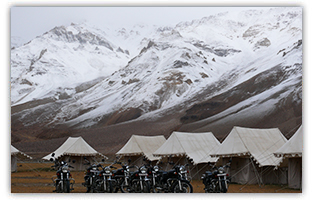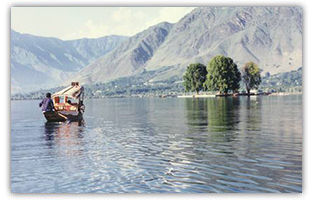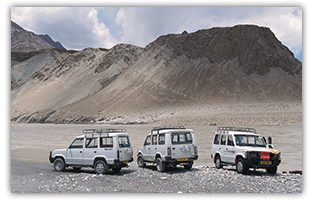Cultural Tours
Safari Tours
Trekking Tours
- Gangabal - Trek
- Lamayaru Alchi - Trek
- Lamayaru Darcha - Trek
- Marcha - Trek
- Spituk - Trek
- Water - Trek
- Zanaskar - Trek
Rafting
Beaches
Angling
Ecotourism
Kahmir Cultural Tours
 The oldest written accounts of Kashmir is found in the sixth century Sanskrit classic, the Nilmatpurna. It begins with a legend : a vast lake, Satisar ( lake of Sati ,the consort of Shiva ) surrounded by towering snow bound mountains , was inhabited by a demon Jalodbhava ( Born of Water ). His victims, the Nags, inhabitants of the mountainous region, appealed to the sage Kashyap, for deliverance .Since the demon was invincible within water, his element ,the sage did great penance and was thus able to secure divine intervention. The mountain to the west of the lake was pierced with a trident and water drained away through this gorge .The demon, deprived of his element ,was easily slain by VISHNU. The valley that emerged from under water was Kashmir , a name said to be the corrupt form of Kashyappur or Kashyap Mar or stretching a point , Ka ( Water ) shimir ( desiccated ).
The oldest written accounts of Kashmir is found in the sixth century Sanskrit classic, the Nilmatpurna. It begins with a legend : a vast lake, Satisar ( lake of Sati ,the consort of Shiva ) surrounded by towering snow bound mountains , was inhabited by a demon Jalodbhava ( Born of Water ). His victims, the Nags, inhabitants of the mountainous region, appealed to the sage Kashyap, for deliverance .Since the demon was invincible within water, his element ,the sage did great penance and was thus able to secure divine intervention. The mountain to the west of the lake was pierced with a trident and water drained away through this gorge .The demon, deprived of his element ,was easily slain by VISHNU. The valley that emerged from under water was Kashmir , a name said to be the corrupt form of Kashyappur or Kashyap Mar or stretching a point , Ka ( Water ) shimir ( desiccated ).
Whatever be the truth of these legends, geological findings confirm that the valley ,with its fossil remains of aquatic animals and plants was once submerged in water. Scientific opinion based on the valleys physical features holds a major volcanic convulsion responsible for draining away the great lake. Another proof of the valley having lain submerged under water for countless years is the peculiar formation of Karewan ( Wudar In Kashmir ) found here.
Nags ( sanskrit for Serpent ) the earliest Inhabitants of Kashmir, are sometimes imagined as human bodied snake worshippers ,sometimes as snake – tailed deities who could assume human form.
According to another myth Kashmiris are believed to be the lost tribe of Israel. And Kashmir the promised land that Moses should have found but did not ! This theory suggests that Jesus Christ, alive after being taken off the cross ,was brought here by his disciples to recover at Aishmuqam near pahalgam.Aish is the local name for Isa ( JESUS ) and muqam means the Place of Stay, but Aish also means , enjoyment, and is quite appropriate as a name for this pretty spot on the banks of the lidder stream. It is believed that Christ was finally buried at Rozabal Khanyar In Srinagar . The name recorded on the shirne at Rozabal is YUZ –ASAF which according to the believers of this theory means Jesus, son of Joseph. Though this theory is an matter of some debate, there is no douht that in spite of its mountainous terrain Kashmir has been remarkably accessible to outsiders. There is evidenace of intercourse with the ancient Greek, Roman and Persian civilizations, as well as those from other parts of India.
 Some Kashmiris believe that the Pandavas of the great Hindu epic the Mahabharata lived and ruled here.In fact the gigantic ruins of old temples in Kashmir are known as Pandav – Lari or the houses of the Pandavas.
Some Kashmiris believe that the Pandavas of the great Hindu epic the Mahabharata lived and ruled here.In fact the gigantic ruins of old temples in Kashmir are known as Pandav – Lari or the houses of the Pandavas.
In the third century BC , Kashmir came under Buddhist influence when Ashoke , the great King,made Srinagar his capital. The Zenith Of Buddhist power in Kashmir was reached in the reign of King Kanishka, convenor of the fourth great Buddhist council which was attended by a large number of scholars, theoreticians and commentors .
Buddhism was followed by a revival of Hinduism and Kashmir was ruled by Hindu rulers till AD 1320.One of the most remarkable Hindu kings was Lalitaditya Muktapida of the karkota dynasty who ruled from AD 724 to 761.Apart from being a millary genius , Lalitaditya was a great builder. His most glorious legacy is the sun temple at Martand , 8 kms from Anathnag, A great warrior, he is often compared to Alexander in his ambitions and successful military campaigns.
When Islam came to the valley in the twelfth century , it did so in a quietly persuasive manner rather than through the power of a strong arm or a royal commandment. The first Islamic preachers who set foot in the valley were Sufis ,the mystic poet –saints of Islalm. They won converts to the new faith even before the beginning of the rule of the first Muslim king Rinchen in1320.the meditative religion of these Muslim mystics was a product of the influence of the austere, inward –, looking ,non violent Mahayana Buddhism of central Asia of Islam. In 1320, the most enlighetened of the Sufis, Bulbul shah came to Kashmir. He is the one who through his piety and remarkable life converted Rinchen to Islam. the interaction of Sufism , Buddhism and Hinduism gave rise to a distinctive form of Sufism the practitioners of which were called rishis in Kashmir. the greatest of these rishis was Sheikh Muruddin , born in 1377, the patron saint of Kashmiris, also known simply as Nund Rishi .His counterpart , born in the middle of the fourteenth century, was Lalla, popularly known as LAL –DAD. Their sayings, highly philosophical and abstract yet most practical, have become maxims that Kashmiris live by and frequently quote . Nund Rishis adage “ AN POSH TELI YELI VAN POSHAN ” meaning ‘ food grains will last only as long as the forests.’ Could very well serve as the slogan of modern conservationists!
Sultan Sikandar was, in fact , a great patron of scholars and gave refuge to many Muslim theologians and Sayyids from Iran who were fleeing from the persecution of Timur. He is the builder of the beautiful hospice at Srinagar , The Khanqah Mohalla.
 The most glorious chapter in the history of ancient and medieval Kashmir was written by Sultan Sikandar’s son Shahi Khan (1420 – 70)who assumed the title of Zain – ul – Abbin. Such was his popularity that he came to be known as Budshah ( The Great King ) .Deeply impressed with central Asian architecture and Iranian arts and crafts ,he invited artists and craftsmen from Iran , Khorasan, and Bukhara to settle in Kashmir, thus laying the foundations of the sophisticated crafts that flowered into the world famous Kashmiri cottage industries of Silk, Carpets, Shawls, Papier Mache and wood carvings. He also had magnificent palaces built ,one of these was Zoonnadub ( literally Moonlit Verandah )
The most glorious chapter in the history of ancient and medieval Kashmir was written by Sultan Sikandar’s son Shahi Khan (1420 – 70)who assumed the title of Zain – ul – Abbin. Such was his popularity that he came to be known as Budshah ( The Great King ) .Deeply impressed with central Asian architecture and Iranian arts and crafts ,he invited artists and craftsmen from Iran , Khorasan, and Bukhara to settle in Kashmir, thus laying the foundations of the sophisticated crafts that flowered into the world famous Kashmiri cottage industries of Silk, Carpets, Shawls, Papier Mache and wood carvings. He also had magnificent palaces built ,one of these was Zoonnadub ( literally Moonlit Verandah )
Native rule came to an end in 1586 with the conquest of Kashmir by Akbar, the great Mughal King of India,and appointed a governor to rule over Kashmir.Akbar built the fort at Hari Pharbat,Jehangir, with his celebrated queen Nur Jahan ,loved Kashmir.The splendid gardens around Ac habal and verinag. the Mughal raod passed over the Pir Panjal which wide enough for huge royal processions. The Mughals are also credited with planting the glorious Chinar ( Platinus Orientalis ) on a large scale.
As Mughal power declined Ahmad Shah Abdali , the Afghan conqueror, invaded and annexed Kashmir in 1953. Fed up with the cruel ,tyrannical and exploitative Afghan rule Kashmiris secretly sought the intervention of Ranjit Singh, the sikh ruler of Panjab .The Afghans were defeated in 1819 and sikh rule established in the state. with the breakup of Sikh empire in 1864, Gulab Singh , Ranjit Singh ‘s emissary in jammu, Ladakh and Baltistan, negotiated a separate treaty with the British at Amritsar. Apart from the territories already in his possession, the valley of Kashmir was handed over to him for Rs 750,000

